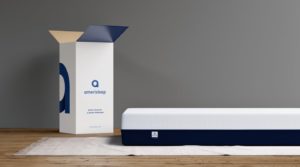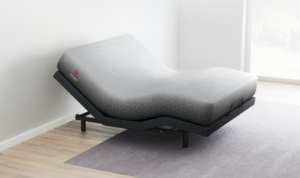Since its debut through NASA in the 1960s, memory foam has changed the way we sleep, offering comfortable, cloud-like softness combined with healthy support. Compared with the previous spring-only options, memory foam opened up a new frontier of sleeping expectations. The memory foam craze has only continued to build as mattress brands release new models.
Over the years, memory foam technology has evolved, offering nuanced mattresses for every preference. A wide variety of memory foams are available, like plant-based, open-cell, and gel memory foam, along with different layering methods to further comfort and support the sleeper.
Our complete guide to memory foam mattresses includes a list of our favorite brands plus a comprehensive guide on what to look for in the best memory foam mattress.
Best Memory Foam Mattresses
| Mattress | Highlights | Price for a queen |
| Amerisleep AS3 | Plant-based Bio-Pur® relieves pressure points with excellent motion isolation. | $1199 |
| Zoma | Eco-friendly Triangulex™ offers a 5-zone support system topped with gel. | $750 |
| Vaya Mattress | Budget-friendly breathable foam mattress suits all sleepers. | $595 |
| Bear | Graphite-infused gel foam pulls heat away from the body. | $840 |
| Original Purple® | The Purple Grid™ automatically adjusts to each sleep position for consistent comfort and support. | $1000 |
1. Amerisleep AS3
Our editors like the Amerisleep AS3 memory foam mattress for many reasons. The 12-inch profile offers versatile support and allows the sleeper to change positions throughout the night without waking others thanks to its excellent motion isolation.
Within the Amerisleep AS3 mattress are three distinct foam layers, each of which plays a significant role in the mattress’s overall performance. 3 inches of Bio-Pur®, a plant-based memory foam, is designed to keep the body cool, relieve, pressure points, and allow for easy movement.
The 2-inch Affinity layer features HIVE® technology to form a 5-zone support system—hundreds of hexagonal-shaped segments create firmer support for the head, back, and legs, and softer support for the shoulders and hips. A sag-resistant foam layer of Bio-Core® evenly supports the body and reinforces the top layers.
Amerisleep offers a 100-night, risk-free trial period, ensuring you have a chance to adjust to the mattress before deciding if it’s right for you. If it isn’t, Amerisleep will provide a full refund and even pick up your mattress for free. The mattress is covered by a 20-year warranty, one of the best in the mattress industry.
2. Zoma
The Zoma Mattress is perfect for anyone with an active lifestyle—from athletes to on-the-go parents—by improving muscle recovery and providing better sleep. This memory foam mattress offers three layers designed for comfort, motion transfer isolation, cooler sleep, and durability.
One of Zoma’s best elements is the Triangulex™ technology built into the first layer of memory foam. The 2-inch Triangulex™ layer contains hundreds of triangular-shaped segments strategically placed to form a targeted support system—the shoulders and hips receive extra cushion while the torso is reinforced. Triangulex™ relieves pain and pressure points while also regulating temperature.
2 inches of latex-like Reactiv™ offer a responsive bounce to encourage spinal alignment. 7 inches of Support+ high-density foam support the body without sagging.
When you purchase the Zoma, you’ll receive a 100-night sleep trial to make sure this mattress is right for your needs.
The Zoma Mattress comes with a 10-year warranty promising complete replacement of the mattress in case of any manufacturing defects or sagging greater than 0.75 inches.
3. Vaya Mattress
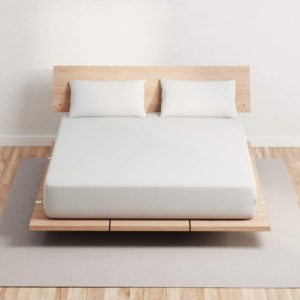 If you’re shopping on a tighter budget, we recommend choosing the Vaya Mattress. This affordable all-foam bed is designed to suit all sleepers because it offers a responsive blend of comfort and support.
If you’re shopping on a tighter budget, we recommend choosing the Vaya Mattress. This affordable all-foam bed is designed to suit all sleepers because it offers a responsive blend of comfort and support.
Two layers make up the Vaya—3 inches of responsive Vaya Foam and 9 inches of sturdy base foam to resist wear and tear. All in all, the Vaya feels medium in firmness.
The Vaya offers plenty of cushioning comfort while keeping you in alignment. The comfort layer of Vaya foam is thick enough to allow for significant pressure relief under the shoulders and hips, making this mattress especially comfortable for side sleepers.
Vaya Sleep sells their Vaya bed online-only, but they offer free shipping, a 100-night sleep trial, and a 10-year warranty with every mattress purchase. If you try it and don’t love it, returns are free, too.
4. Bear
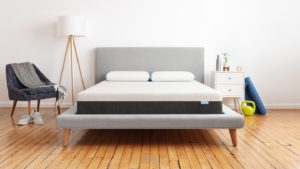
The Bear Mattress features a graphite gel memory foam that disperses heat to ensure you sleep cooler throughout the night. Because the Bear Mattress utilizes CertiPUR-US® certified foams and a water-based bonding solution, it’s both environmentally-friendly and has little to no off-gassing smell.
So what’s the secret behind Bear’s success? The Bear Mattress has 3 key layers that each aid in the perfect night’s sleep.
The mattress cover uses FDA-determined Celliant® technology, which transforms body heat into infrared energy, ensuring the bed remains cool with little risk of overheating.
Underneath, the 2-inch cooling graphite-infused gel memory foam removes unwanted body heat and is supported by a responsive 3-inch layer of transitional foam that offers pressure relief alongside balanced support. And at the base of the mattress, you’ll find a 5-inch layer of high-density support foam created to provide long-lasting durability.
Bear includes a 100-night sleep trial to give you plenty of time to ensure the mattress is the right fit for you. Bear requires you to keep the mattress for at least 30 nights prior to initiating a return, should you choose to do so. The mattress also comes with a 10-year warranty to protect against defects and sagging greater than 1 inch.
5. Original Purple®
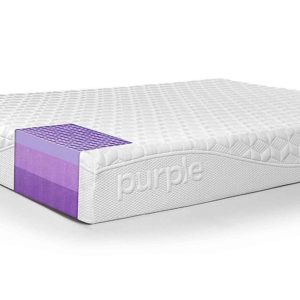
At 9.5 inches tall, the Original Purple® mattress is a great choice. The Purple Grid™ automatically adjusts to each sleep position and body type by collapsing under pressure without risk of sagging. The grid system provides air channels throughout the top layer to prevent overheating.
The top layer features 2 inches of the Purple Grid™ to relieve pressure points and provide better airflow for optimal cooling. 3.5 inches of poly-foam is designed to align the spine and prevent sagging. Finally, the 5-inch base layer of poly-foam evenly supports the body and reduces motion transfer.
The Purple® mattress comes with a 100-night sleep trial—but Purple® requires its customers to keep the mattress for at least 21 days before issuing any returns. The mattress also includes a 10-year warranty, protecting against manufacturing defects which cause the foam to crack and sagging greater than 1 inch.
What is Memory Foam?
Memory foam, also known as viscoelastic polyurethane foam, is a material commonly found in mattresses, pillows, and mattress toppers. Memory foam changes shape when pressure and heat are applied to it—heat causes the foam to soften, conforming to the natural curves of the body, and relieving pressure points. Once pressure is removed, memory foam cools and firms, retaining its original shape.
Memory foam is also known for its excellent motion isolation and minimal noise potential—sleepers won’t have to worry about waking from their partner’s movement.
Generally, a memory foam mattress contains a comfort layer of memory foam and a support layer of high-density foam.
Types of Memory Foam
One of the biggest concerns with memory foam mattresses is heat retention. Traditional memory foam is known for its dense nature which traps heat, leading to sleep disruptions.
To combat this problem, many memory foam manufacturers produce memory foam layers designed to increase airflow from within the mattress to keep sleepers at a cool and comfortable temperature. A popular method is infusing the memory foam with gel beads to absorb and evenly disperse body heat.
Other cooling methods alter the structure of traditional memory foam. For example, partially replacing petroleum with plant-based oils or injecting the foam with air results in breathable, more responsive foam.
Traditional Memory Foam
Traditional memory foam mattresses are vastly different from innerspring mattresses because they cradle the body. The soft material alleviates pressure points on the body, resulting in a healthier night’s sleep. The foam material also provides excellent motion isolation to lessen the likelihood of waking up when sharing the bed with a sleep partner.
Traditional memory foam is antimicrobial, helping to combat the buildup of allergens and bacteria which may cause irritation or exacerbate existing allergies.
A drawback to traditional memory foam is that it retains heat. Customers who want a memory foam mattress should look for cooling memory foams like plant-based, gel, or open-cell memory foam.
Plant-Based Memory Foam
Plant-based memory foam is designed to reduce emissions by partially replacing petroleum with plant oil. This results in an eco-friendly mattress with more breathability and no chemicals such as formaldehyde, phthalates, and others.
Gel Memory Foam
Cooling gel memory foam has the same properties as traditional memory foam except for its inherent cooling properties.
Gel memory foam’s cooling capabilities are due to infusing gel or gel beads or swirling gel into the material. Gel memory foam is often recommended to people looking for additional cooling, like those suffering from physical ailments that interrupt sleep. Consult your doctor to make sure a gel memory foam mattress is right for your treatment plan.
Open-Cell Memory Foam
While all memory foams have open-cell structures, some manufacturers take it a step further by injecting even more air, resulting in breathable, responsive memory foam. More air pockets provide better air circulation within the mattress.
What to Look for in a Memory Foam Mattress
Before committing to a potential purchase, customers need to look at specific factors, including density and ILD rating, budget, and preferred sleep position. Also, check out what type of sleep trial or return policy is available and the mattress’s warranty.
Density and ILD Rating
To determine the quality of the memory foam, potential shoppers should look at the foam density and ILD rating.
Density
Density refers to the level of support memory foam offers. Density measures the number of pounds found within a cubic foot of foam, determining the weight, or how well the memory foam supports the body. Low-density foams are less durable than higher density foams because they have less material and are more likely to break down over time.
- Low: 2.5 to 3.9
- Medium: 4.0 to 5.4
- High: 5.5 and higher
ILD Rating
ILD, or Impression Load Deflection, determines the firmness of the memory foam by measuring how much pressure it takes to make a 4-inch indentation on the sleep surface. The higher the ILD rating, the firmer the foam, and the lower the ILD rating, the softer the foam.
- Extremely soft: 8 to 10
- Very soft: 11 to 15
- Soft: 16 to 21
Budget
Memory foam mattresses cost anywhere between $300 to over $2000 for high-end models. High-quality memory foam mattresses cost an average of $1045, an affordable price for any quality mattress.
Collect as much information on each mattress as you can from the store, online, and from mattress reviews. Once you’ve done your research on the brands you’re interested in, check to see if there are any current sales or discounts available. Online mattress companies are a good choice because they offer high-quality materials at low prices by cutting out the middleman. Also, since customers don’t usually have the opportunity to try out the mattress in person before buying it, online mattress companies provide extended sleep trials.
Body Weight
Body weight has a huge impact on the type of mattress you purchase. Choosing a mattress based on body weight and favorite sleeping position ensures you receive the best mattress for your needs.
Weight is broken into three categories—lightweight, average, and heavy. Each body type requires a specific firmness to balance comfort and support without misaligning the spine.
- Lightweight: weighing 130 pounds and less
Lightweight sleepers need a soft to medium-soft mattress to allow the body to slightly sink into the mattress, cushioning the body and relieving pressure points.
- Average weight: weighing between 130 and 230 pounds
Average weight sleepers need a medium-soft to medium-firm mattress to align the spine and relieve pressure points.
- Heavyweight: weighing 230 pounds and more
Heavyweight sleepers need a medium-firm to firm mattress to provide support without the risk of sagging.
Sleeping Position
Your preferred sleep position has a tremendous impact on the kind of memory foam mattress you choose. Memory foam is available in various firmness levels— each sleep position needs a specific level with the right amount of comfort and support to keep the spine in neutral alignment.
Side Sleeping
Side sleeping is one of the healthiest and most common sleep positions. Sleeping on the side allows for better breathing, reduces acid reflux symptoms, and alleviates pressure on vital organs.
Memory foam mattresses with a soft to medium feel are the best for side sleepers because they contour to the body and release pressure on the hips and shoulders.
Back Sleeping
Back sleeping is the second healthiest sleep position. Back sleepers are able to naturally align their spine because of the back’s direct contact with the mattress surface.
The best memory foam mattress for back sleepers ranges between a medium and firm feel— firm enough to provide support but soft enough to relieve pressure points. The hips should sink slightly to align the spine.
Stomach Sleeping
Stomach sleeping is one of the unhealthiest sleep positions, because of the high risk of neck strain and lower back pain. Twisting the head at an unnatural angle to breathe causes neck pain. Lower back pain results from gravity forcing the spine’s natural curve out of alignment.
Memory foam mattresses with a medium-firm to firm feel are the best for stomach sleepers since a firmer surface keeps the body on top of the mattress with minimal pressure relief to prevent misaligning the spine.
Sleep Trials, Warranties, and Return Policies
Mattress manufacturers provide sleep trials, warranties, and return policies to assure the customer of a sound purchase. Always read the fine print of each policy.
Sleep Trial
Sleep trials allow customers to try out a new mattress in the comfort of their own home— these are especially common with bed in a box mattress brands since the customer typically isn’t able to try out the mattress before buying. These trial periods last between 90 to 120 nights. If the customer isn’t happy with the mattress, most companies will pick up the bed before issuing a full refund.
Warranty
A warranty protects the mattress against manufacturing defects (such as cracked or bunched foam) and sagging greater than 1 inch (the measurement varies depending on the brand). Most mattresses come with a standard 10-year warranty.
Return Policy
In case a sleep trial isn’t available, the next best thing is to look for a return policy. Most return policies last 30 days— about the same amount of time it takes to adjust to a new mattress. If the customer isn’t satisfied with the bed, they can return it for a full refund.
FAQs
How much should I spend on a good memory foam mattress?
Most queen-size memory foam mattresses cost anywhere between $1,000 to $2,000, and many people spend around $1,500. You can usually find better deals when shopping with online brands, especially since they run plenty of sales throughout the year.
Can memory foam mattresses really help with back pain?
Sleeping on a memory foam mattress isn’t a cure for back pain, but these beds can ease aches and pains because they contour to the body to ease pressure and help you feel weightless as you sleep. Many of the best memory foam mattresses contain zoned support technologies, and these are what really help to nib back pain in the bud. Zoned support technologies offer, as you might guess, zoned support, so each part of your body receives the right level of comfort and support to achieve healthy sleep.
When you sleep in a healthy position and receive adequate pressure relief, it boosts recovery and prevents discomfort, which is why so many sleepers with back pain who switch to memory foam find relief.
Are memory foam mattresses comfortable for everybody?
Due to the immense variety of memory foam mattresses on the market, it’s safe to say there’s a comfortable memory foam mattress option out there for everybody. Most often, side sleepers and those with chronic pain find memory foam most comfortable because it offers cushion for heavy and sore parts of the body.
Stomach sleepers may struggle most to find a supportive memory foam mattress because those who sleep on their stomachs need a very firm and responsive bed to keep the belly from sinking. Stomach sleeping can lead to long-term lower back pain so we suggest avoiding stomach sleeping and switching to side sleeping if possible.
How long do memory foam mattresses last?
The lifespan of a memory foam mattress often depends on how well it’s cared for and the quality of the materials. A well-cared-for memory foam mattress is likely to last between 8-10 years.
Another way to extend the life of your mattress is by purchasing a mattress protector. Mattress protectors guard against spills and stains, preventing damage.
Should I add a mattress topper to my memory foam mattress?
A mattress topper alters the feel of the sleep surface, transforming your current mattress into a more comfortable bed. If you just bought a memory foam mattress and want to modify the feel of it, a mattress topper can do the trick. Toppers can either add softness to a too firm mattress or more support to a too-soft surface. Please note: a mattress topper won’t correct a sagging mattress—they are only a temporary solution to sagging.
Conclusion
Memory foam mattresses are an excellent choice for potential buyers looking for a bed with optimal pressure relief. Traditional memory foam retains heat, which is why choosing a memory foam mattress with cooling properties is the best choice. Plant-based foam or gel memory foam provides better sleep without the risk of overheating.
